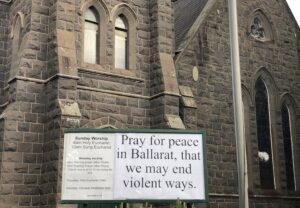Bishop warns Synod Church’s immediate future “is not bright”

By Stephen Cauchi
7 September 2017
The Anglican Church has accepted a blueprint for its future, with the its lead author predicting that the Church would decline further before it recovered.
Bishop Andrew Curnow of Bendigo, who chaired the Viability and Structures Steering Group, told the General Synod that the Church’s immediate future was not bright.
Some parishes in the Church were “travelling well”, Bishop Curnow said.
But overall, “when you look at the overall position of our Church in Australia, we haven’t reached the bottom of the J-Curve and I would put it to you we’ve got a fair way to go”.
Many churches, particularly in rural areas, were struggling or closing, he said.
Bishop Curnow said that the blueprint – the Viability and Structures Steering Group Report – was not as specific as the Steering Group had wanted.
He listed five recommendations that the Group had wanted to include in the Report, but did not because they got “cold feet”.
“These recommendations are there to give you a taste of the sorts of specific things we really started to deal with, but at the last minute, perhaps, we got cold feet and began to feel it’s too big, it’s too hard, and it just won’t get through General Synod.
“But it’s important to state them.”
The Report, as passed by Synod, has numerous recommendations.
They include:
*a requirement that each diocese develop a Mission Action Plan, including timelines and resource requirements;
*recognition that all growth will come through faithful action trusting in God’s enlivening work;
*a request that each diocese construct a holistic ministry and mission plan for young people.
The five recommendations that weren’t included were:
1.That a rural institute of ministry be established;
2.That the Diocese of the Northern Territory be transferred to the Province of South Australia;
3.That the Province of NSW urgently address the number of dioceses in the Province that are not viable;
4.That the dioceses of Brisbane, Sydney and Melbourne give greater episcopal autonomy to their regions, similar to that of English dioceses;
5.That a working group be established to draft a new Australian Church constitution.
Bishop Curnow said the Church faced testing times ahead.
He said that many in Church had “a hope and expectation that the good old days will come back… that we only have to work harder, or convert more people, or start more churches, or be more intentional about our theological education.”
But God may have other ideas, he said. God may intend “that we might need to be in exile for some time before we really know who we are… as the people of God”.
The future of the Church could get “far worse”, he said. To deal with such a future, the Church must “travel by faith and not by sight”.
The Church was “travelling with the hope that God will reveal the way forward. And that might have nothing to do with how hard we work, or organise, or regulate, or pass legislation – it might be in the hands, literally, of God.”
The Church may be a “long way off”, he said, “before we have new breath and new life and a new sense of where God is leading us.”
Bishop Curnow reminded the Synod that the 2016 Census showed that the percentage of Australians identifying as Anglicans had declined to 13 per cent nationally – from 17 per cent in 2011 – with a high of 18 per cent in Tasmania and 9 per cent in Victoria.
Kalgoorlie priest Revd Dr Elizabeth Smith, speaking during the debate, said many Anglican churches over the next 20 years were going to die and the Church was not prepared.
The Church should appoint a team that could help Bishops and other senior leaders “train to close what must be close”.
“Would there be the possibility that nationally we could provide people with expertise in the emotional, spiritual, social, economic, financial and theological issues around dying?
“Because the better we manage the dying, the less futile effort we spend resisting the dying, and the more attention that we will be able to pay to resurrection when it stirs – because stir it will. The spirit is out there.”






